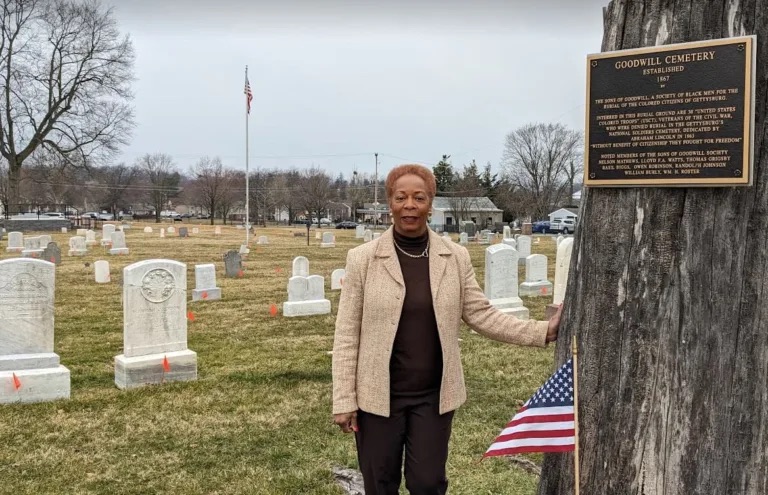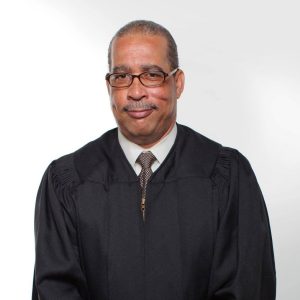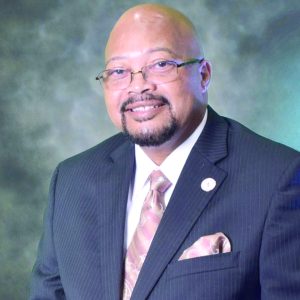The Battle of Gettysburg and the Siege of Vicksburg both ended on July 4, 1863. Both were enormous victories and the turning point of the war that ended in May 1865. Gettysburg and Vicksburg became famous homes to National Cemeteries, the final resting place of thousands of troops having fought and died on the Civil War battlefields.
More than 17,000 Civil War dead were buried in Vicksburg. And more than 7,240 of these were Black troops.
Gettysburg, with about 6,000 gravesites, had no Black Civil War troops buried there, initially. Years later, two members of the USCT were given their final rest there.
The Soldiers’ National Cemetery, now known as Gettysburg National Cemetery, is world famous. Abraham Lincoln consecrated the cemetery with his Gettysburg Address on November 19, 1863. Delivering “a few appropriate remarks” – his two minute-long “Gettysburg Address” – he overshadowed the keynote speakers’ two-hour address a thousand-fold.
In 1872, the federal government took stewardship over the cemetery and it has been known as Gettysburg National Cemetery since.
DUE RESPECT
There is, however, another cemetery in Gettysburg – the Lincoln Cemetery – that receives a lot less attention. Located on Lincoln Lane, the cemetery is home to around 30 Black Civil War veterans, and about 400 other Black decedents who were brought in from other cemeteries over the years.
“These men were not buried in the Soldiers’ National Cemetery…because they were African-American,” says Gettysburg writer-lecturer Savannah Labbe. “While they were allowed to fight for their freedom, even in death, these men were still not equal to the white soldiers they fought beside.”
As of June 26, a coalition of Black and white history buffs, benevolent societies, and community activists have decided to combine their forces in an attempt to turn Gettysburg around and put an end to the paucity of Black inclusion.
Opportunely timed between Memorial Day and July 4, the Gettysburg Black History Trail was launched just in time for the July 4, 2024 commemoration of the famous Battle of Gettysburg.
At the forefront of the effort to give Gettysburg’s Black community its due respect is Jean Green, president of the Lincoln Cemetery Project Association.
“My family has been here since the 1890s and many of them are buried here,” Green said. “I want to make sure I’m doing everything for the benefit of people who are buried here.
“We’ve been walking over folks and don’t know it. One goal of the association is to procure headstones for each of the unknown bodies. We’ll try our best to put a name to them,” she said.
There are 250 graves with headstones, and 136 unknown in Lincoln Cemetery, she said.
Lincoln Cemetery is so precious to the Black community, she said, “because it is the only concrete evidence that there was a thriving Black community here in Gettysburg.”
Gettysburg, under Pennsylvania law, is defined as a borough, rather than as a city, town, or township.
HISTORY TRAIL
While the burial site was popularly known as “the colored cemetery” after it was built in 1867, the name of Goodwill Cemetery held sway for a number of years and later was changed to Lincoln Cemetery after a benevolent society took on the task of maintaining the cemetery in 1906.
Gettysburg’s rich history somehow landed in the 21st Century with an important segment of its past overlooked.
The Black History Trail is a cooperative project supported by a coalition of Gettysburg/Adams County groups.
The cemetery is one of eleven stops on the Gettysburg Black History Trail, and has a phone app created in cooperation with the Adams County Historical Society, Destination Gettysburg, Gettysburg Black History Museum, Gettysburg Foundation, Gettysburg National Military Park, Lincoln Cemetery Project Association, Seminary Ridge Historic Preservation Foundation, and Thaddeus Stevens Society.
BLACK MAYOR
Gettysburg Mayor Rita C. Frealing, the borough’s first Black mayor, was elected in 2021 and lives near Lincoln Cemetery. She frequently visits the burial ground to reflect on its history, she says.
“It’s a very important part of our community, and it’s now becoming a point of pride in our community because of so many people putting an effort into it,” she says.
The mayor’s mother was a close friend of local Black cultural pioneer and activist Betty Dorsey Myers, author of the book Segregation in Death: Gettysburg’s Lincoln Cemetery.
“It’s going to make a difference, knowing about the Black families that shaped Gettysburg, what their part was,” Frealing said of the new Black Heritage Trail. And it’s going to bring information about the US Colored Troops that are buried here. Yes, it’s going to open an entirely new era of Black history in Gettysburg. The cemetery is just a part of our heritage, and Jean Green is carrying on the tradition.”
FOUNDING FATHERS
The Sons of Good Will, three prominent African Americans in Adams County, met in 1866 to find a good place to bury Black Civil War veterans. In 1867, they bought a half-acre of land on the outskirts of Gettysburg and developed a plan to build what was known then as “the Good Will Cemetery. The Lincoln Cemetery merged with the St. Paul AME Zion Church Cemetery in 1906 and took full charge of cemetery operations when Zion pulled out. They then moved the bodies from Zion Cemetery to Lincoln Cemetery, leaving the borough with only one Black cemetery.
The Sons of Good Will ceased to exist in 1916, and the cemetery was sold to Lincoln Lodge 145, thereby acquiring the name Lincoln Cemetery. But around 1934 all the Lodge members had deceased and the cemetery fell into serious disrepair.
In the 1970s, Alpha Phi Omega Fraternity at Gettysburg College began working to restore the cemetery to an acceptable standard and gave it back to AME Zion Church.
The Lincoln Cemetery Project Association was established in the late 1990s to help preserve the cemetery and raise awareness of its existence. They appealed to the borough and community to help with maintenance.
Gettysburg has gained national recognition for its Main Street Program for advancing historic preservation and economic development.






